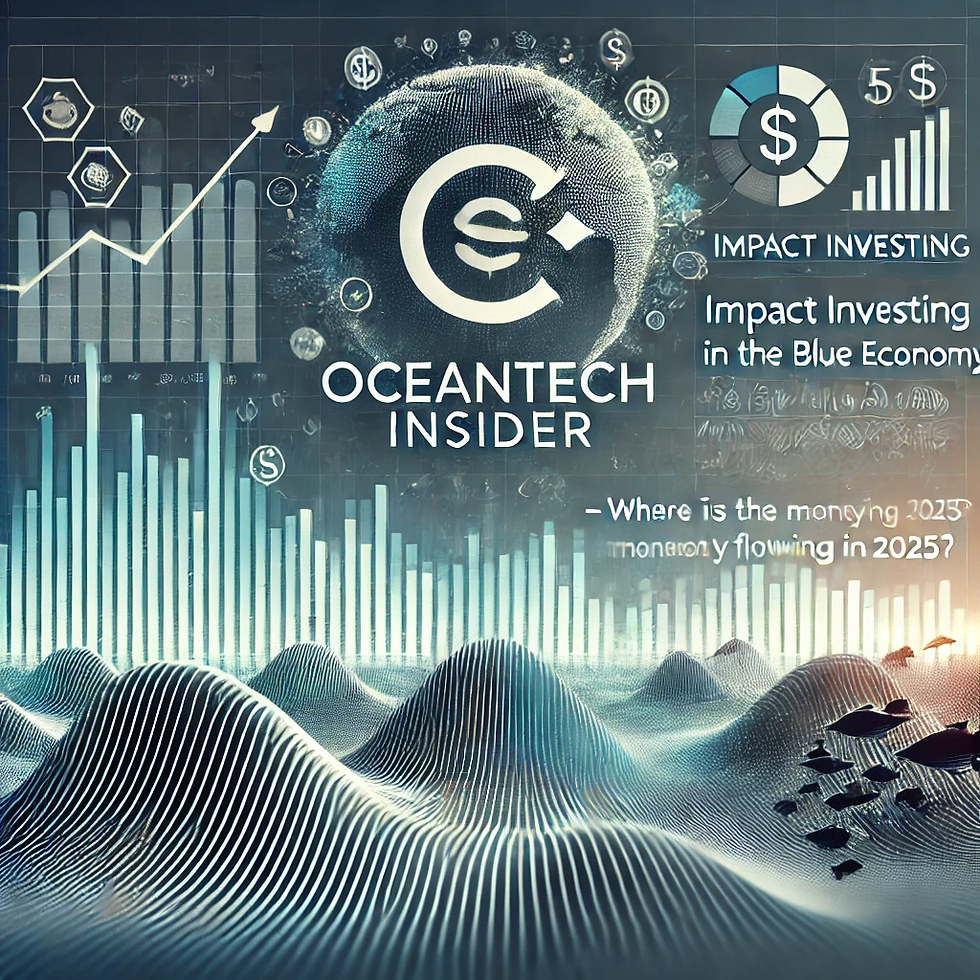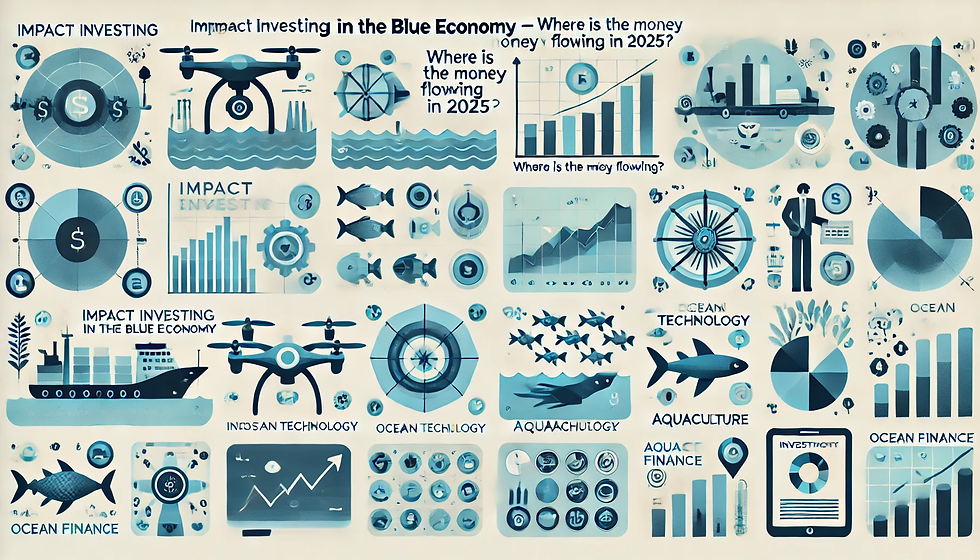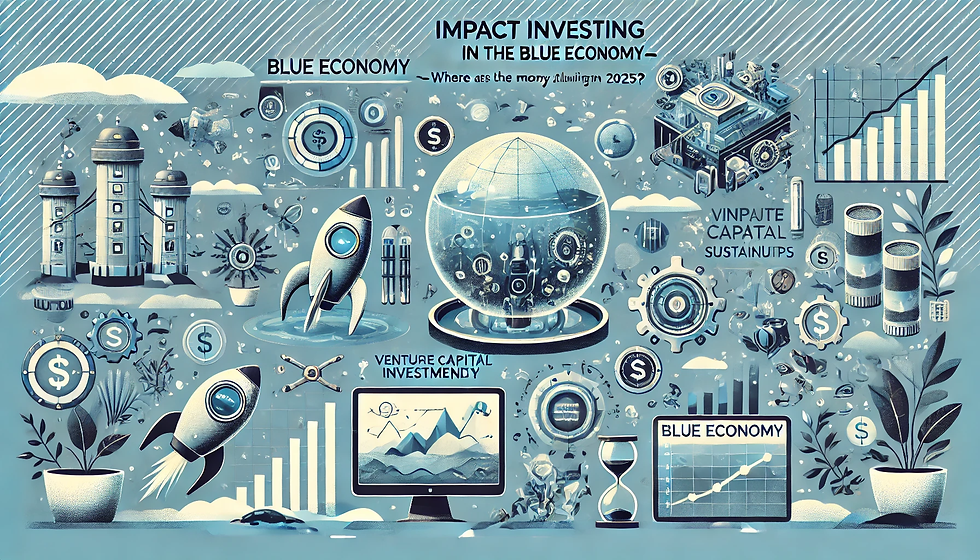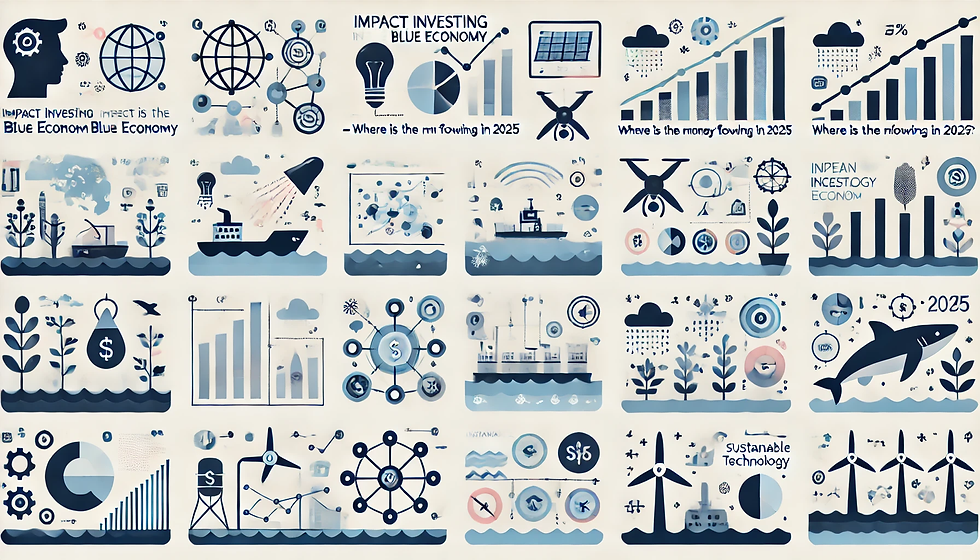Post #50: Impact Investing in the Blue Economy – Where is the Money Flowing in 2025?
- henry belfiori
- Jan 31
- 8 min read
Welcome to This Week’s OceanTech Insider!
This week, we dive into one of the fastest-growing investment frontiers—the blue economy. With capital flowing into marine renewable energy, AI-driven ocean tech, and sustainable aquaculture, investors are beginning to see the ocean as more than just a resource, but maybe a market of the future? Where is the "smart money" going, and what challenges remain? 🌊
Please note that "blue" is used heavily and can be an interchangeable yet vague word just like the western world's favourite "sustainability". For the purpose of this piece, it is anything to do with the sea.
Enjoy:)

The Blue Economy as an Investment Opportunity
The blue economy is no longer a niche sector—it is emerging as a key area of global investment, with financial markets increasingly recognising the ocean’s role in economic growth, sustainability, and technological innovation. Traditionally, investment in marine industries has been dominated by shipping, fisheries, and offshore oil and gas. However, in recent years, a shift towards blue technology, marine renewable energy, and sustainable ocean solutions has accelerated.
According to the World Economic Forum, the blue economy contributes $1.5 trillion annually to the global economy and is expected to double in size by 2030, outpacing many traditional sectors. With advancements in marine robotics, AI-driven ocean monitoring, sustainable aquaculture, and offshore energy, investors are beginning to view blue tech as a high-growth market rather than a risk-heavy environmental play.
This blog explores the key trends in blue economy investment, including where private capital is flowing, which blue tech sectors are gaining traction, and the financial instruments fuelling growth. As global interest in ocean-based solutions increases, understanding the opportunities and challenges in this evolving market is crucial for investors and entrepreneurs alike.
Growth Trajectory of the Blue Economy
A Sector Moving Beyond Traditional Marine Industries
For decades, ocean-based industries were largely confined to extractive sectors—fishing, offshore oil, and shipping—attracting investment based on their established economic importance. However, growing concerns over climate change, resource depletion, and environmental degradation have led to a fundamental shift in how the ocean is valued. Instead of focusing solely on extraction, investors are turning towards ocean conservation, renewable energy, and marine technology.
Key Investment Trends and Market Growth
Global Market Size: The blue economy currently contributes $1.5 trillion annually to the world economy and is expected to reach $3 trillion by 2030.
Investment Growth Rate: The sector is projected to grow at twice the rate of the global economy, with key drivers being technological advancements, regulatory support, and rising demand for sustainable solutions.
Shift in Capital Allocation: Over the past five years, venture capital, private equity, and sovereign funds have increased their allocation to blue economy startups, marine infrastructure, and conservation projects.
Why Investors Are Paying Attention
Growing Profitability of Sustainable Marine Ventures – Unlike a decade ago, ocean-focused startups and projects are now demonstrating strong/good financial returns, particularly in renewable energy and marine technology.
Regulatory Tailwinds – Governments and international organisations are increasing their commitment to marine sustainability, leading to incentives, subsidies, and funding initiatives that make investment in the sector more attractive.
Technological Maturity – Advances in AI, robotics, and marine biotech have made blue economy investments more scalable and commercially viable, reducing risks previously associated with the sector.
The Role of Institutional and Private Investors
The growth of institutional capital in the blue economy signals a mainstream acceptance of ocean-based industries as investable and profitable. Traditional investors are now competing with impact-driven funds, sovereign wealth funds, and corporate-backed venture arms to secure stakes in high-growth marine ventures.
The next sections will explore where this capital is flowing, the blue tech sectors seeing the highest growth, and the financial instruments enabling further expansion.

Key Investment Sectors in Blue Tech
As the blue economy continues to gain traction, investment is increasingly being directed toward high-growth blue tech sectors that offer both financial returns and long-term sustainability benefits. The following industries are attracting the most capital, driven by technological advancements, policy incentives, and shifting investor priorities.
1. Marine Renewable Energy
Why It’s Attracting Investment:
The offshore wind market is now a major driver of renewable energy investment, with new projects scaling rapidly across Europe, the U.S., and Asia.
Tidal and wave energy technologies, once considered too experimental, are reaching commercial viability, with private and public funds backing pilot projects.
The global push for energy security is increasing investment in ocean-based renewables as a diversified energy source.
Investment Highlights:
$35 billion was invested in offshore wind projects globally in 2023, with projections reaching $100 billion annually by 2030.
Venture capital (VC) and private equity are moving into tidal energy, with companies such as Orbital Marine Power (UK) and SIMEC Atlantis Energy receiving significant funding.
Sovereign wealth funds and large asset managers are increasing stakes in offshore energy infrastructure, particularly in the North Sea, the U.S. East Coast, and Southeast Asia.
2. Sustainable Aquaculture & Alternative Proteins
Why It’s Attracting Investment:
Global seafood demand is expected to increase by 50% by 2050, making sustainable aquaculture a necessity.
New technologies such as AI-driven fish farming, automated feeding systems, and alternative seafood production are revolutionising the industry.
Investors are funding companies that reduce reliance on wild-caught fish, decrease environmental impacts, and increase scalability.
Investment Highlights:
Private investment in high-tech aquaculture exceeded $1 billion in 2024, with major deals in AI-enhanced fish farming, recirculating aquaculture systems (RAS), and alternative seafood production.
Companies such as BlueNalu and Finless Foods (cell-based seafood) have raised over $200 million in venture funding.
Institutional investors are backing sustainable feed solutions, including algae-based proteins that reduce overfishing pressures on wild stocks.
3. Ocean Conservation & Monitoring Technologies
Why It’s Attracting Investment:
Governments and regulatory bodies require better data-driven solutions to monitor and protect marine environments.
AI-powered ocean mapping, real-time pollution tracking, and autonomous marine drones are making conservation efforts more effective.
The rise of blue carbon markets (seagrass and mangrove restoration) is creating new asset classes for investors.
Investment Highlights:
The ocean monitoring market is expected to surpass $20 billion by 2030, with growing private-sector involvement.
Companies such as OceanMind and PlanetWatchers are using AI and satellite data to track illegal fishing and marine pollution, securing funding from tech investors and environmental funds.
The blue carbon credit market is emerging as a viable investment class, with venture-backed projects in seagrass restoration and kelp farming.
4. Marine Robotics and AI for Ocean Exploration
Why It’s Attracting Investment:
Advances in autonomous underwater vehicles (AUVs), AI-powered marine drones, and deep-sea sensors are revolutionising ocean exploration.
These technologies are unlocking commercial opportunities in deep-sea mining, undersea infrastructure, and oceanographic research.
Defence and security applications are driving government-backed investments in marine robotics.
Investment Highlights:
The global marine robotics market is projected to reach $12 billion by 2030, growing at a 15% CAGR.
Companies such as Saildrone and Ocean Infinity are attracting major funding rounds to expand their AI-driven ocean mapping and survey capabilities.
Investors are increasingly backing deep-sea exploration technologies, with private capital funding automated subsea research platforms.

Emerging Financial Mechanisms in the Blue Economy
As investment in the blue economy accelerates, new financial instruments are emerging to fund ocean-based ventures and drive sustainable economic growth. Traditional venture capital and private equity remain key players, but innovative financing models such as blue bonds, blended finance, and debt-for-nature swaps are expanding access to capital and attracting new investors to the sector.
This section explores the mechanisms driving blue economy investment, their impact, and key case studies.
1. Blue Bonds: Mobilising Capital for Ocean Sustainability
What Are Blue Bonds?
Blue bonds function similarly to green bonds but focus exclusively on marine conservation, sustainable fisheries, and ocean-based climate resilience projects.
Issued by governments, development banks, or corporations, they raise funds from institutional and private investors to finance ocean-related initiatives.
Investors receive a fixed return, while funds go towards projects such as marine protected areas, ocean restoration, or sustainable aquaculture.
Investment Impact:
The World Bank’s Seychelles Blue Bond (2018) raised $15 million to support marine conservation and sustainable fisheries, becoming a blueprint for future issuances.
The Asian Development Bank (ADB) is planning $5 billion in blue bond investments by 2030 to fund ocean health projects across Asia and the Pacific.
The European Investment Bank (EIB) has issued blue bonds to fund sustainable port infrastructure and ocean resilience initiatives.
2. Blended Finance: Reducing Investment Risk in Blue Tech
What is Blended Finance?
Blended finance combines public, philanthropic, and private sector funding to de-risk ocean investments and attract institutional capital to the blue economy.
Governments or development finance institutions (DFIs) provide concessional capital, making ocean investments less risky for private investors.
Used to fund early-stage blue tech startups, infrastructure projects, and conservation initiatives.
Investment Impact:
The Global Fund for Coral Reefs ($500 million) uses blended finance to protect coral ecosystems while funding reef-based businesses such as sustainable tourism and biotech startups.
The Sustainable Ocean Fund, backed by DFIs and private investors, has invested in fisheries reform, regenerative aquaculture, and ocean plastics recycling ventures.
The EU’s BlueInvest platform is blending public and private capital to scale high-growth blue tech startups.
3. Debt-for-Nature Swaps: Converting Debt into Ocean Conservation
What Are Debt-for-Nature Swaps?
These agreements reduce national debt in exchange for commitments to marine conservation.
Governments negotiate with creditors to redirect debt payments into ocean sustainability projects rather than traditional repayments.
Increasingly used in developing economies with rich marine biodiversity but high debt burdens.
Investment Impact:
In 2022, Belize secured a $364 million debt-for-nature swap, committing to protecting 30% of its marine territory in exchange for reduced national debt obligations.
The Seychelles debt conversion (backed by The Nature Conservancy) is financing marine protected areas and sustainable fisheries initiatives.
More countries with significant marine biodiversity (such as Indonesia and the Philippines) are exploring debt-for-nature mechanisms to support ocean sustainability.
Challenges and Considerations for Investors in the Blue Economy
While investment in the blue economy is growing, it is not without challenges. The sector requires long-term commitment, regulatory navigation, and a balance between profitability and sustainability. Investors need to assess risks carefully while identifying scalable opportunities.
Regulatory Uncertainty – Ocean industries are subject to complex international laws, environmental policies, and shifting government priorities. Investors must navigate evolving regulations, particularly in areas such as marine energy, fisheries, and conservation finance.
Scalability and Market Readiness – Many blue tech solutions are still emerging, requiring early-stage capital and patient investment strategies. Scaling marine innovations can be slower compared to land-based technologies due to infrastructure constraints and environmental dependencies.
Risk Management and Capital Intensity – Offshore projects, ocean robotics, and marine biotech often require significant upfront investment with longer return timelines. Investors must assess risks related to climate change impacts, geopolitical shifts, and technological feasibility.
Bridging Public and Private Investment – The success of blue bonds, blended finance, and sovereign-backed initiatives shows the need for collaboration between governments, development banks, and private investors to de-risk and scale ocean-based ventures.

The Blue Economy as a New Investment Frontier
The blue economy is transitioning from a niche impact sector to a mainstream investment opportunity. With private capital increasing, new financial instruments emerging, and blue tech innovations scaling, the market is poised for rapid growth.
While challenges remain, the momentum is somewhat clear: marine renewable energy, AI-driven ocean monitoring, sustainable aquaculture, and conservation finance are attracting serious investment.
For those willing to navigate the complexities, the blue economy offers not only high-growth potential but also a chance to shape the future of our planet’s most valuable resource—the ocean. Now is the time to act, invest, and innovate in this ocean-driven economic revolution.
Thank you for reading this edition of OceanTech Insider! Your engagement helps drive important discussions on the intersection of technology, investment, and ocean conservation. If you found this piece insightful, please share your thoughts in the comments, repost it with your network, or start a discussion.
Warm wishes,
H
“Some people don’t like change, but you need to embrace change if the alternative is disaster.” - Elon Musk
Sources
Introduction & Section 1: Growth Trajectory of the Blue Economy
Section 2: Key Investment Sectors in Blue Tech
https://www.iea.org/reports/offshore-wind-outlook-2023
https://www.nature.com/articles/s41598-024-41127-9 (Marine renewable energy investment trends)
https://www.fao.org/documents/card/en/c/cc2997en/ (Sustainable aquaculture investment trends)
https://www.noaa.gov/news-release/new-ai-driven-tools-for-ocean-monitoring (AI in ocean conservation)
https://www.worldbank.org/en/news/feature/2023/06/12/how-blue-carbon-credits-are-helping-finance-ocean-restoration
Section 3: Emerging Financial Mechanisms in the Blue Economy
https://www.worldbank.org/en/news/press-release/2018/10/29/seychelles-launches-worlds-first-sovereign-blue-bond
https://www.eib.org/en/press/all/2023-077-european-investment-bank-announces-first-blue-bond-issuance
https://www.oceanpanel.org/ocean-finance (Blended finance in the blue economy)
https://www.nature.org/en-us/explore/newsroom/belize-blue-bond-conservation (Belize debt-for-nature swap)
Section 4: Challenges and Considerations for Investors
https://www.unep.org/resources/report/ocean-finance-handbook (Challenges in scaling ocean finance)
https://www.nber.org/papers/w30945 (Risks in marine investment markets)
https://blueinvest-eu.azurewebsites.net (EU’s BlueInvest initiative for de-risking ocean startups)
Comentários